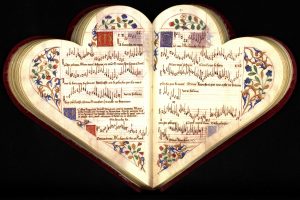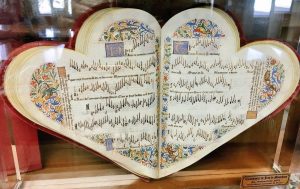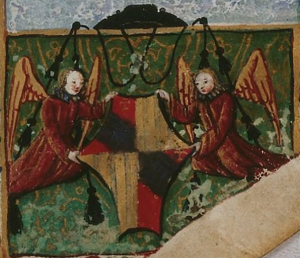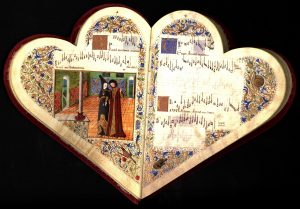Chansonnier Cordiforme

The Chansonnier Cordiforme, also known as the Chansonnier de Jean de Montchenu (M 2 .C42 M66 1460a) is a heart-shaped book of love songs, produced between 1460 and 1477. It contains “fourteen pieces with Italian texts and thirty with French texts,” representing “some of the most popular and widespread chansons of the day, as well as some found only in a few other sources.” Sixteen of the songs are unique to the Chansonnier Cordiforme.[1] A recording of the songs can be found here.

The Cordiforme is printed on parchment bound in red velvet in the shape of a double heart, symbolizing the unity of two hearts in love. The volume is illuminated in the Gothic style with illuminated initials that begin the songs and with flowers, animals, monsters, and people on the borders of the pages. It has two detailed miniatures: an image of a young noblewoman being shot with cupid’s arrow as the goddess Fortuna looks on, and an image of the woman walking arm in arm with a nobleman.[2] Whenever the word for “love” appears in the text, it is replaced with a symbol of a heart.

The Chansonnier Cordiforme was commissioned by Jean de Montchenu, a French clergyman who was reputed to be “an advocate of romantic love between people at the French royal court,” as well as “a great scoundrel, shameful of conduct, highly unchaste, detestable, dissolute, and full of vice.”[3] It was eventually acquired by Baron James de Rothschild and was donated with his library to the Bibliothèque Nationale de France, where it is currently housed.[4] BYU’s facsimile is one of 1380 numbered copies signed by a notary.[5]

Edward Kottick described how scholars were able to date the Chansonnier using the details of a hat above the heraldry in the Cordiforme: “The black color of the hat indicates that the ecclesiastic station of the wearer was below that of a bishop; the number of tassels on the hat establishes his rank as priest. From study of these details the date of compilation of the manuscript can be fixed: between 1460 and 1476. It is known that before 1460 Jean was only a canon at St. Antoine, and would not have had the priestly number of tassels on his hat. In 1477 he became Bishop of Agen (in title only) and in 1478 was appointed Bishop of Viviers. As a bishop, his hat would have been red, with one more tassel on each side; therefore, he probably acquired the chansonnier prior to 1477.”[6]
If you have any questions about the Chansonnier Cordiforme, please contact the Curator of Music Special Collections at david_day@byu.edu
[1] Edward L. Kottick, “The Chansonnier Cordiforme,” Journal of the American Musicological Society 20, no. 1 (January 1, 1967): 13, 19, https://doi.org/10.2307/830452.
[2] Ziereis Faksimiles, “Chansonnier de Jean de Montchenu,” Ziereis Facsimiles, n.d., https://www.facsimiles.com/facsimiles/chansonnier-de-jean-de-montchenu.
[3] Leech-Wilkinson, Daniel, “Le Chansonnier Cordiforme,” Early Music 9, no. 2 (April 1981): 214, https://www.jstor.org/stable/3126298.
[4] Edward L. Kottick, “The Chansonnier Cordiforme,” Journal of the American Musicological Society 20, no. 1 (January 1, 1967): 10–27, https://doi.org/10.2307/830452.
[5] “Chansonnier de Jean de Montchenu. | BYU Library,” n.d., https://lib.byu.edu/search/byu/record/cat.6343230.item.31197237755225?holding=8prokmzcn7t57mbx.
[6] Edward L. Kottick, “The Chansonnier Cordiforme,” Journal of the American Musicological Society 20, no. 1 (January 1, 1967): 12, https://doi.org/10.2307/830452.